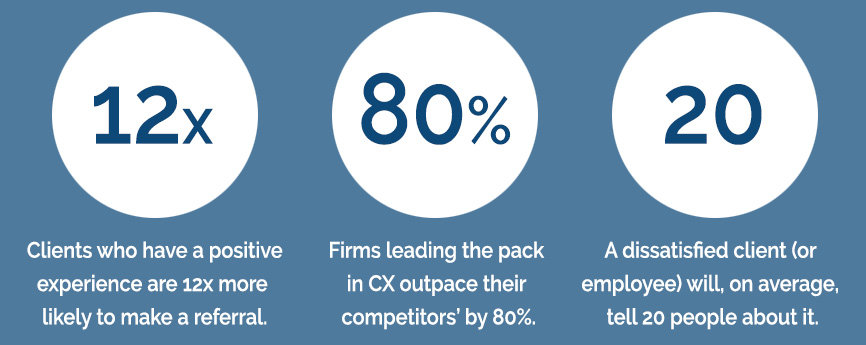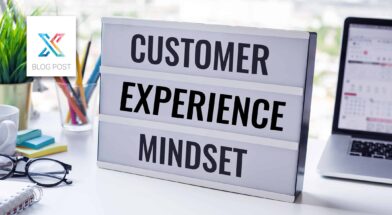You’re a believer.
In this competitive marketplace, you see the positive ROI numbers firms that have implemented Employee Experience (EX) and Client Experience (CX) as an operational discipline are achieving. And you want the same success trajectory for your firm. So, you do your homework, and your firm embarks on a new CX initiative with the goal of improving both your employees’ and your clients’ experience. The result. You overhear your employees commenting on how this new initiative is just like all the rest. Going nowhere.
How can this be?
The thing about CX and EX initiatives, as with most business strategies, it’s next to impossible to get positive outcomes by trying to follow some textbook solution. And, like most business strategies, without a comprehensive understanding of how all the pieces fit together, CX and EX initiatives can fall far short of expectations and/or negatively affect the outcome you expect.
A Vicious Cycle
Recently a COO of a 400-person firm asked me “What do you mean it can create a negative outcome? If I at least try to improve my employees’ experience, will it not at least benefit them and the firm a little bit?”
In this example, the COO was doing what a lot of firm leaders have started doing as part of their employee experience initiative. They’re asking for internal feedback once a year. Great, right? Well it could be. But without a way to identify the connection between the responses and a strategy to prioritize the feedback they received; the firm failed to execute effectively. What the employees saw was that they provided the information requested and nothing (or next to nothing) was done about the feedback received. This scenario will absolutely cause negative and disruptive outcomes.
Let’s look at how this seemingly positive strategy turned into a vicious cycle for this firm. After engaging with them and digging a little bit deeper, here’s what we found:
- Employees were frustrated with the fact that they provided their leaders with the feedback they asked for and never heard anything more about it.
- There were a lot of internal conversations among employees focused on the amount of discontent they had with leadership and their inability to implement change.
- In some cases, employees were (believe it or not) discussing their discontent with clients.
- Their employees were even more disengaged after this initiative.
- Employee attrition rose over the industry average of 18.9% to 21%, which cost the firm $8,400,000.
- The firm lost more clients in this year than they had in the past 5 years.
- The firm’s Net Promoter Score (NPS) dropped 15 points in 1 year.
And they tell 20 people . . .
Hence the Vicious Cycle. Employees are no different than consumers overall. And the research is clear when it comes to dissatisfaction. People who are dissatisfied will, on average, tell 20 others (including clients) about the situation that has made them unhappy. Clearly, one bad employee experience leads to overall employee dissatisfaction as each dissatisfied employee spreads their discontent. The firm loses the employee and maybe the client if that employee holds the relationship. The firm loses money, which may result in the need to cut costs which could worsen other employee experiences, and the snowball effect occurs. A vicious cycle.
The good news is, it is possible to break the vicious cycle. Here are a couple of steps that Client Savvy has worked with this firm to accomplish in the past month to do just that:
- Created an internal communications plan for implementing change around the employee experience. Instead of only doing an annual internal feedback request, the firm has provided ongoing feedback from their team with acknowledgment of their input.
- Created an EX/CX Cohort that has the power to make a change, when change is necessary. This removed the red tape and showed staff that they meant business. This cohort provides updates on strategies for implementation OR reasons why a specific request will not be implemented at this time.
Note: This same scenario holds true with initiatives implemented to improve your clients’ experience. Great CX and EX lead to so many benefits for an organization, and it is cross-organizational. Everyone benefits!
A Virtuous Cycle
Someone said to me this past weekend, it’s all about recognizing that you don’t know what you don’t know. That’s where having an expert’s voice can help your firm create a virtuous cycle.
In contrast to my last example, here is the story of a CEO of a 150-person multi-practice law firm. She approached our team about a year ago and asked a lot of probing questions regarding how CX and EX could help them accomplish their goals. Their specific goals included increased cross-selling opportunities, higher profitability, more negotiated contracts vs. competitive engagements, transfer of brand loyalty from specific individuals to the firm overall, and increased employee retention.
Sound familiar? It should! After being in business for 16 years, these are some of the most common goals/challenges we hear in the professional services marketplace. In this scenario, this CEO knew her business and what she wanted to accomplish. She also recognized what she didn’t know - how to effectively implement a CX and EX strategy to help her achieve these goals. This firm brought our team in to collaborate with them from the outset. Here’s what they did to help achieve their goals:
- They implemented a client listening program to capture qualitative and quantitative data and analytics on how their clients were perceiving their team’s hard skills, soft skill, and deliverables.
- They used the data (feedback) they received to design a consistent delivery process across all matters, matter sizes, geographies, etc.
The rest of the story
In addition to the specific positive outcomes from these efforts, having a coordinated process allowed the firm to enjoy this virtuous cycle:
- They leveraged the positive feedback and comments they received on individuals in their different practice areas to reduce internal fear and increase cross-selling opportunities. They now had data to prove that other attorneys were delivering great experiences to their clients as well!
- With this increase in cross-selling, their clients formed additional strong relationships with others in the firm leading to increased loyalty to the firm overall, and not just the individual.
- It also deepened the firm’s relationships inside of the client creating more stakeholders to vouch for the firm going forward.
- The firm now had more opportunity for negotiated contracts, which meant higher profitability because the client had more stakeholders involved who wanted to work with this firm specifically. (Consistent delivery experience is key here)
- Net Promoter Score rose 10 points in one year. (According to Client Lifetime Value analysis, this meant hundreds of thousands of dollars added to their bottom line).
- Improved the employee experience, happy clients = happy employees.
- In the first year, they improved employee retention by 6%.
- Increased their ability to recruit (and retain) top talent by sharing their consistent service delivery process as part of their interview and onboarding process.
- Targeting the areas that specifically needed attention, the firm reduced training costs while increasing opportunities for training overall. This strategy reduced overhead costs while increasing team satisfaction and engagement.
Vicious or Virtuous?
As compelling as these stories may be, your story while in some respects similar, is almost certainly different. Our experience has shown us that while there may be similarities in our clients achieving their strategic priorities, each client is different and there is no such thing as a textbook solution. Email us at answers@clientsavvy.com or contact us at https://calendly.com/clientsavvy/30.
You know your strategic priorities. Client Savvy can help you integrate the CX and/or EX pieces together to enable your initiative to create a virtuous cycle that continues to drive benefit for your firm.






